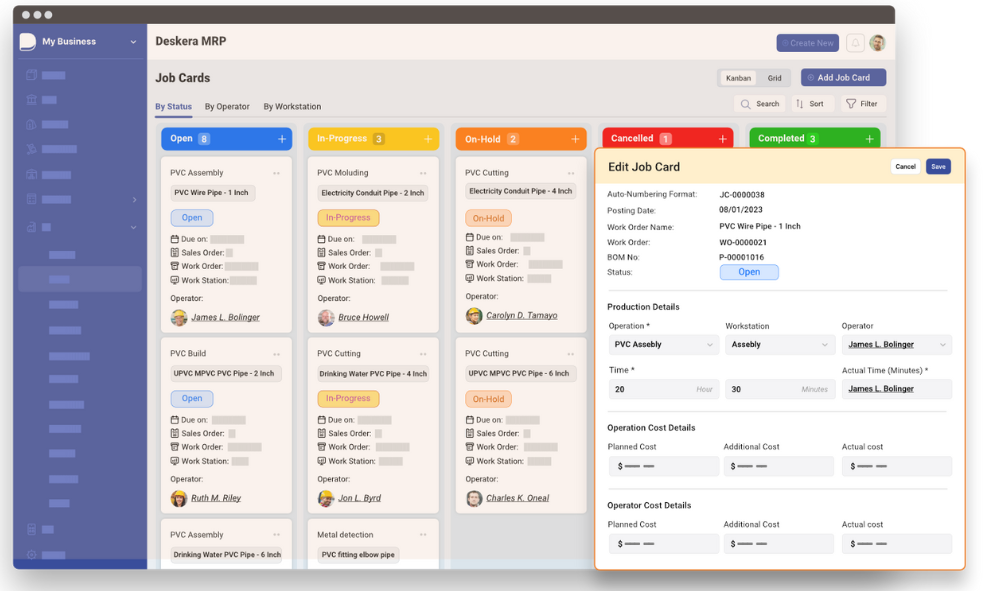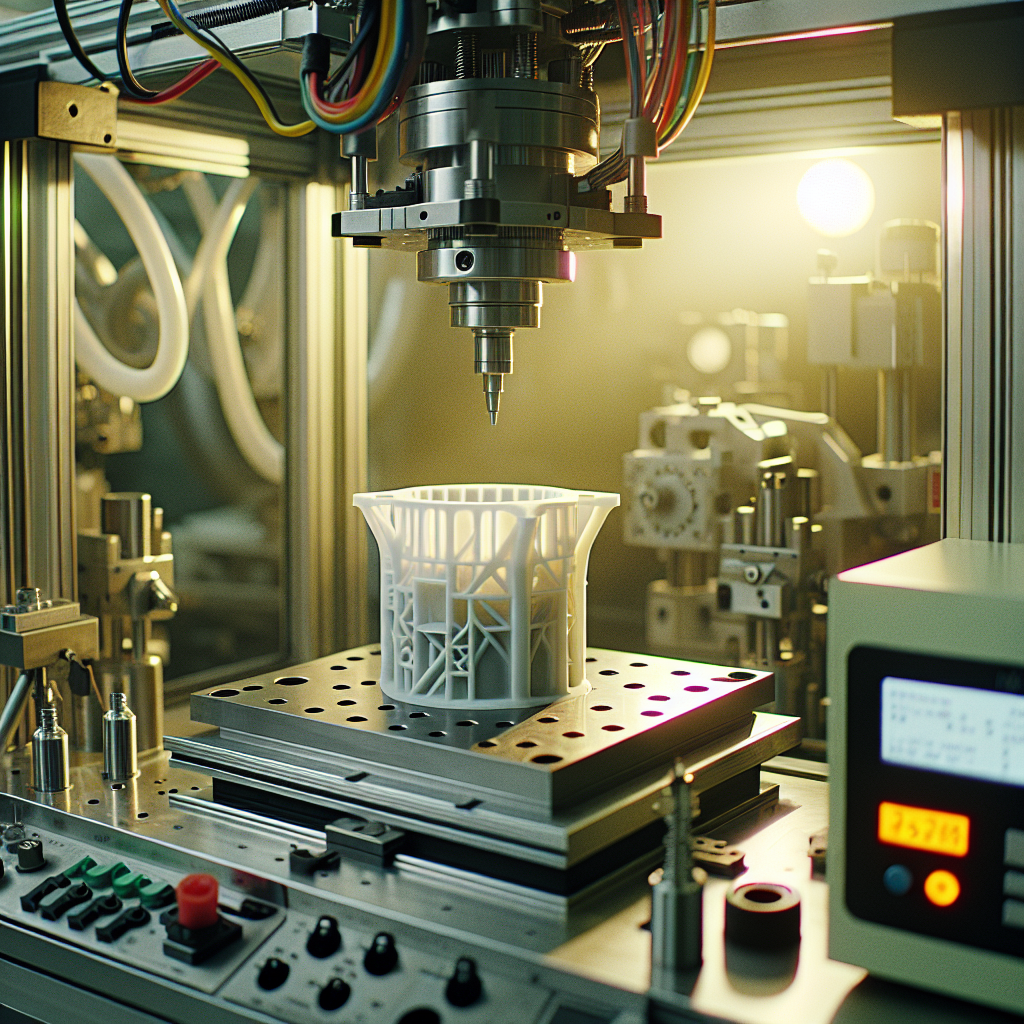Staying competitive requires more than just producing quality goods. It demands a deep understanding of costs, efficiencies, and the ability to make data-driven decisions in real time.
This is where real-time finished goods costing emerges as a game-changer. By providing up-to-the-minute visibility into the costs associated with manufacturing processes, real-time costing empowers organizations to optimize their operations and drive efficiency like never before.
The ability to accurately track costs throughout the production cycle allows businesses to identify bottlenecks, reduce waste, and make timely adjustments to improve overall productivity.
Moreover, the study revealed that companies adopting real-time costing achieved a 15% reduction in inventory carrying costs, thanks to streamlined inventory management and demand forecasting.

In this article, we will delve deep into the impact of real-time finished goods costing on manufacturing efficiency. We will explore the benefits it offers, the challenges that may arise during implementation, and real-life success stories from companies that have embraced this innovative approach.
Additionally, we will discuss future trends and opportunities that lie ahead, revolutionizing the way manufacturing organizations optimize their operations.
- Importance of Cost Management in Manufacturing
- Introduction to the Concept of Real-time Finished Goods Costing
- Understanding Real-time Finished Goods Costing
- Benefits of Real-time Finished Goods Costing
- Challenges and Considerations
- Future Trends and Opportunities
- Conclusion
- How can Deskera Help You?
- Key Takeaways
- Related Articles
Importance of Cost Management in Manufacturing
Cost management plays a pivotal role in the success and sustainability of manufacturing businesses. It involves the systematic planning, monitoring, and controlling of expenses associated with production processes, materials, labor, overhead, and other resources.
The importance of cost management in manufacturing can be understood through the following key points:
Profitability: Effective cost management directly impacts the profitability of manufacturing companies. By optimizing costs, businesses can maximize their profit margins and achieve a competitive advantage in the market. It allows organizations to price their products competitively while still maintaining profitability, ensuring long-term financial viability.
Operational Efficiency: Cost management promotes operational efficiency by identifying and eliminating wasteful practices, inefficiencies, and redundancies. By understanding and controlling costs, manufacturers can streamline their processes, improve resource allocation, and enhance overall productivity. This leads to higher output levels, reduced lead times, and improved customer satisfaction.
Decision Making: Accurate cost information enables informed decision making at various levels within a manufacturing organization. It helps managers evaluate the financial implications of different alternatives, such as investing in new equipment, changing suppliers, or modifying production processes. By considering the cost aspect, decision makers can make strategic choices that optimize resource utilization and support the organization's goals.
Budgeting and Forecasting: Effective cost management facilitates budgeting and forecasting activities. By having a clear understanding of costs, manufacturers can develop realistic budgets, allocate resources appropriately, and monitor actual expenses against projected figures. This enables proactive financial planning, early identification of deviations, and the ability to take corrective actions promptly.
Continuous Improvement: Cost management is closely tied to the concept of continuous improvement in manufacturing. By monitoring and analyzing costs, businesses can identify areas for improvement, implement cost-saving measures, and drive operational excellence. Regular cost analysis encourages a culture of innovation and efficiency, fostering ongoing improvements across the entire manufacturing process.
Introduction to the Concept of Real-Time Finished Goods Costing
Unlike traditional costing methods that rely on periodic assessments or estimates, real-time costing provides up-to-the-minute visibility into the actual costs incurred throughout the manufacturing process. By leveraging advanced technology and integrated software systems, manufacturers can capture and analyze data on factors such as raw material usage, labor expenses, overhead costs, and other relevant variables as products are being manufactured.
This real-time cost information empowers businesses to make informed decisions, optimize operations, and drive efficiencies. It enhances cost visibility and accuracy, enables better decision-making, improves manufacturing efficiency by identifying bottlenecks and waste, and streamlines inventory management.
Embracing real-time finished goods costing is crucial for manufacturers looking to gain a competitive edge and achieve operational excellence in today's rapidly evolving business landscape.
Understanding Real-time Finished Goods Costing
To fully comprehend the impact of real-time finished goods costing on manufacturing efficiency, it is crucial to delve into a comprehensive understanding of this innovative approach. By exploring its definition, key components, and underlying processes, we can unlock the transformative power of real-time costing in the manufacturing industry.
Definition and explanation of real-time finished goods costing
Real-time finished goods costing is a method of cost management in manufacturing that involves continuously tracking and analyzing the costs associated with producing finished goods in real time.
Unlike traditional costing methods that rely on periodic assessments or estimates, real-time costing provides up-to-the-minute visibility into the actual costs incurred throughout the manufacturing process.
This approach involves leveraging advanced technology and integrated software systems to capture and analyze data related to various cost factors, including raw material usage, labor expenses, overhead costs, and other relevant variables. The data is collected and processed in real time, allowing manufacturers to have accurate and timely cost information at their disposal.
Real-time finished goods costing enables businesses to make data-driven decisions based on real-time cost data, leading to enhanced cost visibility and accuracy. It helps identify cost inefficiencies, optimize resource allocation, and drive overall manufacturing efficiency.
By having instant access to precise cost information, manufacturers can take timely actions to control costs, improve profitability, and gain a competitive edge in the market.
Overview of the key components and processes involved
Real-time finished goods costing involves several key components and processes that contribute to its effective implementation. Here is an overview of the main components and processes involved:
Data Collection: The first step in real-time costing is the collection of relevant data. This includes capturing data on raw material consumption, labor hours, machine utilization, energy consumption, and other cost-related variables. Data can be collected through various sources such as sensors, automated systems, barcode scanning, and integration with enterprise resource planning (ERP) software.
Data Integration: The collected data is then integrated into a centralized system or software platform that consolidates and organizes the information. Integration ensures that real-time cost data is readily available for analysis and decision-making purposes. This may involve linking the data with other systems such as inventory management, production planning, and financial accounting systems.
Cost Calculation: Once the data is collected and integrated, the next step is to calculate the costs associated with producing finished goods in real time. This involves applying cost algorithms and formulas based on predefined cost structures, labor rates, overhead rates, and other relevant factors. Advanced costing systems can automate this process, enabling swift and accurate cost calculations.
Real-time Reporting and Analysis: The calculated costs are then presented through real-time reporting and analysis dashboards. These dashboards provide visual representations of cost data, such as cost breakdowns by product, production line, or specific cost categories. Real-time reporting allows manufacturing managers to monitor costs, identify cost drivers, and analyze cost trends for proactive decision-making.
Decision Making and Optimization: Armed with real-time cost information, manufacturing decision-makers can identify areas for improvement and optimization. They can make data-driven decisions to optimize resource allocation, improve operational efficiency, reduce waste, and enhance profitability. Real-time costing enables timely adjustments and corrective actions to be taken to address cost variances and improve overall manufacturing performance.
Technology and software systems used for real-time costing
Real-time finished goods costing relies on advanced technology and software systems to capture, process, and analyze cost data in real time. Here are some of the key technologies and software systems commonly used in real-time costing:
Enterprise Resource Planning (ERP) Systems: ERP systems serve as a central hub for integrating and managing various aspects of manufacturing operations, including real-time costing. They provide modules and functionalities specifically designed for capturing cost-related data, such as material usage, labor hours, machine utilization, and overhead costs. ERP systems allow for seamless integration between different departments and enable real-time access to cost information.
Internet of Things (IoT): IoT technology plays a crucial role in real-time costing by enabling the collection of real-time data from sensors, devices, and machines on the shop floor. Connected sensors and IoT devices track variables like machine performance, energy consumption, temperature, and other relevant metrics. This data is then fed into the real-time costing system, providing accurate and up-to-date information for cost calculations.
Data Analytics and Business Intelligence Tools: Real-time costing requires robust data analytics and business intelligence tools to process and analyze the collected data. These tools provide functionalities for data visualization, cost reporting, and trend analysis. They help manufacturing managers gain insights into cost drivers, identify inefficiencies, and make data-driven decisions to optimize operations.
Costing Software Solutions: There are dedicated costing software solutions available that focus specifically on real-time costing. These software tools offer features such as cost calculation algorithms, cost tracking dashboards, and real-time reporting capabilities. They streamline the process of collecting, calculating, and analyzing costs in real time, providing manufacturing organizations with accurate and actionable cost insights.
Cloud Computing: Cloud-based technologies enable real-time access to cost data from anywhere, facilitating collaboration and decision-making across multiple locations or departments. Cloud-based platforms also offer scalability, allowing manufacturers to handle large volumes of data in real time without the need for significant infrastructure investments.
These technology and software systems work in tandem to enable real-time costing in manufacturing. By leveraging these tools, organizations can capture, process, and analyze cost data in real time, leading to enhanced cost visibility, improved decision-making, and increased manufacturing efficiency.
Benefits of Real-time Finished Goods Costing
Real-time finished goods costing brings a host of benefits to manufacturing organizations, empowering them to achieve greater cost visibility, optimize operations, and make informed decisions.
By exploring the advantages it offers, we can uncover the transformative impact of real-time costing on manufacturing efficiency. From enhanced cost accuracy and improved decision-making to streamlined inventory management, this section delves into the benefits that organizations can unlock by embracing real-time finished goods costing.
Enhanced cost visibility and accuracy
One of the key benefits that real-time finished goods costing brings to manufacturing organizations is enhanced cost visibility and accuracy. By adopting this innovative approach, businesses gain a clear and real-time understanding of the costs associated with their production processes.
How real-time costing provides accurate and up-to-date cost information
Real-time costing provides accurate and up-to-date cost information by leveraging advanced technology and integrated data systems. Here are some key factors that contribute to the accuracy and timeliness of cost information in real-time costing:
Real-time Data Capture: Real-time costing relies on the continuous capture of data related to various cost factors, such as raw material usage, labor hours, machine performance, and overhead costs. This data is collected directly from the production floor through sensors, IoT devices, automated systems, and other data collection methods. By capturing data in real time, organizations ensure that cost information is based on the most current and accurate data available.
Integration with Operational Systems: Real-time costing systems are integrated with operational systems such as enterprise resource planning (ERP), manufacturing execution systems (MES), and other relevant software platforms. This integration allows for seamless data flow and synchronization between different systems, ensuring that cost data is consistently updated and reflects the latest production activities.
Automation and Data Processing: Real-time costing utilizes automation and advanced algorithms to process and calculate costs based on the captured data. Automated calculations eliminate manual errors and discrepancies that can arise from traditional costing methods. The use of predefined cost structures, labor rates, and overhead rates further enhances accuracy by providing standardized and consistent cost calculations.
Instantaneous Reporting and Analysis: Real-time costing systems provide instantaneous reporting and analysis capabilities. The collected cost data is processed and presented through real-time dashboards, allowing stakeholders to access up-to-date cost information whenever needed. This enables quick decision-making based on accurate cost insights and eliminates the delays associated with waiting for periodic cost reports.
Integration with Financial Systems: Real-time costing systems are often integrated with financial systems, such as accounting and budgeting software. This integration ensures that the cost information generated by real-time costing aligns with the organization's financial records, providing a comprehensive view of costs throughout the entire financial ecosystem.
Impact on decision-making and cost control
Real-time finished goods costing has a significant impact on decision-making and cost control within manufacturing organizations. Here are the key ways in which real-time costing enhances decision-making and enables effective cost control:
Informed Decision-Making: Real-time costing provides decision-makers with accurate and up-to-date cost information, enabling them to make informed decisions. By having instant access to the actual costs incurred throughout the manufacturing process, managers can evaluate the financial implications of different options, such as changing suppliers, altering production processes, or investing in new equipment.
This allows for data-driven decision-making that considers the cost aspect, leading to more effective resource allocation and optimized operational strategies.
Cost Variance Analysis: Real-time costing allows for continuous monitoring and analysis of cost variances. By comparing actual costs against standard or target costs in real time, organizations can identify discrepancies and take immediate action to control costs. Cost variance analysis helps detect inefficiencies, bottlenecks, or unexpected cost increases, allowing managers to address them promptly and prevent further financial impact.
Timely Cost Control: Real-time costing facilitates proactive cost control measures. With real-time visibility into costs, organizations can implement timely adjustments and optimizations to reduce expenses. For example, if a cost deviation is identified, such as excessive material usage or labor inefficiencies, corrective actions can be taken promptly to mitigate the impact on overall costs.
Real-time costing enables organizations to identify cost-saving opportunities, streamline operations, and implement cost-control measures in a timely manner.
Performance Evaluation: Real-time costing provides a basis for evaluating the performance of various cost drivers and departments within the manufacturing process. By analyzing cost data in real time, organizations can identify areas of high or low cost efficiency and take appropriate actions. This enables continuous improvement efforts and fosters a culture of cost consciousness throughout the organization.
Forecasting and Budgeting Accuracy: Accurate and real-time cost information obtained through real-time costing contributes to more precise forecasting and budgeting processes. By having a clear understanding of current costs, organizations can make more accurate predictions and set realistic budgets. This helps prevent cost overruns, improves financial planning, and ensures that the organization operates within its financial means.
Improved manufacturing efficiency
Improved manufacturing efficiency stands as a key benefit derived from the adoption of real-time finished goods costing. By harnessing the power of accurate and timely cost information, organizations can identify and address inefficiencies, optimize resource allocation, and make timely adjustments to enhance overall productivity.
This section explores how real-time costing drives manufacturing efficiency, enabling organizations to streamline operations, reduce waste, and achieve higher levels of output and customer satisfaction.
How real-time costing helps identify inefficiencies and waste
Real-time costing plays a crucial role in identifying inefficiencies and waste within manufacturing processes. By continuously tracking and analyzing cost data in real time, organizations can pinpoint areas where resources are being underutilized or expenses are unnecessarily incurred.
Here's how real-time costing helps in identifying inefficiencies and waste:
Immediate Visibility: Real-time costing provides instant visibility into cost data, allowing organizations to identify inefficiencies as they occur. By comparing actual costs with expected or standard costs in real time, discrepancies and deviations can be promptly detected. This immediate visibility enables timely intervention to address inefficiencies and minimize waste.
Granular Cost Breakdown: Real-time costing provides a granular breakdown of costs at various levels, such as by product, process, or production line. This detailed cost information helps identify specific areas where inefficiencies or waste may be occurring. It allows organizations to analyze cost drivers, such as excessive material usage, idle time, or energy consumption, and take targeted actions to improve efficiency.
Process Mapping and Analysis: Real-time costing enables organizations to map and analyze their manufacturing processes in real time. By closely monitoring costs at each stage of production, organizations can identify bottlenecks, redundancies, or non-value-added activities that contribute to inefficiencies or waste. This insight enables process optimization, streamlining operations, and eliminating unnecessary steps or resources.
Continuous Improvement: Real-time costing facilitates a culture of continuous improvement by highlighting areas for optimization. With the ability to track costs in real time, organizations can set benchmarks, establish performance targets, and measure progress towards efficiency goals. This iterative approach allows for ongoing monitoring and refinement of processes, leading to continuous improvements in productivity and waste reduction.
Root Cause Analysis: Real-time costing provides a valuable tool for conducting root cause analysis when inefficiencies or waste are identified. By analyzing cost data alongside other relevant data sources, organizations can trace the underlying causes of inefficiencies.
This analysis helps identify systemic issues, process bottlenecks, or skill gaps that contribute to waste. Addressing these root causes leads to sustainable improvements in manufacturing efficiency.
Ability to make timely adjustments and optimizations
Real-time finished goods costing empowers organizations with the ability to make timely adjustments and optimizations within their manufacturing processes. By leveraging real-time cost information, organizations can identify areas for improvement, respond quickly to changes, and optimize operations for maximum efficiency.
Here's how real-time costing enables timely adjustments and optimizations:
Instant Cost Insights: Real-time costing provides immediate and accurate cost insights, allowing organizations to identify cost deviations or unexpected expenses as they occur. This timely information enables quick response and the ability to take immediate action to address cost-related issues. Organizations can identify cost-saving opportunities, make adjustments to resource allocation, or implement process improvements promptly.
Proactive Decision-Making: Real-time costing equips decision-makers with real-time data to make proactive decisions. With up-to-date cost information, organizations can assess the financial impact of different alternatives and make informed choices to optimize operations. Whether it's adjusting production schedules, reallocating resources, or revising procurement strategies, real-time costing enables decision-makers to respond swiftly to changes and make proactive adjustments to maximize efficiency.
Agile Resource Allocation: Real-time costing facilitates agile resource allocation by providing visibility into cost drivers and resource utilization in real time. With this information, organizations can optimize resource allocation based on demand fluctuations, production priorities, or cost-efficiency considerations. Timely adjustments in resource allocation, such as labor, machinery, or materials, ensure optimal utilization and minimize waste or idle time.
Continuous Process Optimization: Real-time costing enables continuous process optimization by highlighting inefficiencies or areas for improvement. Organizations can monitor cost data in real time to identify process bottlenecks, redundancies, or non-value-added activities. By making timely adjustments to streamline processes, eliminate waste, or improve throughput, organizations can achieve ongoing improvements in manufacturing efficiency.
Adaptability to Changing Conditions: Real-time costing enables organizations to adapt to changing market conditions, customer demands, or supply chain disruptions. By continuously monitoring costs and analyzing real-time data, organizations can quickly assess the financial impact of changes and make necessary adjustments. This adaptability allows organizations to remain agile and responsive to dynamic business environments.
Streamlined inventory management
Streamlined inventory management stands as a significant benefit derived from the implementation of real-time finished goods costing. By leveraging accurate and up-to-date cost information, organizations can optimize their inventory levels, improve demand forecasting, and ensure efficient stock control.
This section explores how real-time costing enhances inventory management practices, enabling organizations to reduce carrying costs, minimize stockouts, and achieve better overall inventory performance.
How real-time costing helps optimize inventory levels
Real-time costing plays a crucial role in optimizing inventory levels and reducing carrying costs while minimizing stockouts. By providing accurate and up-to-date cost information, real-time costing enables organizations to make informed decisions regarding inventory management.
Here's how real-time costing helps optimize inventory levels and reduces carrying costs and stockouts:
Accurate Demand Forecasting: Real-time costing provides real-time visibility into cost data, allowing organizations to analyze demand patterns and trends accurately. By integrating cost information with demand data, organizations can make more accurate demand forecasts. This ensures that inventory levels are aligned with anticipated customer demand, reducing the risk of overstocking or stockouts.
Efficient Replenishment Planning: Real-time costing enables organizations to optimize replenishment planning for raw materials or finished goods. By tracking costs in real time, organizations can proactively identify when to reorder materials or replenish inventory based on cost factors, such as supplier pricing or production costs. This allows for timely and efficient replenishment, avoiding excess inventory and minimizing stockouts.
Minimized Carrying Costs: Real-time costing helps minimize carrying costs associated with inventory. With accurate cost information, organizations can make informed decisions about order quantities, storage, and carrying durations. By optimizing inventory levels based on real-time cost insights, organizations can reduce the expenses related to holding excess inventory, including storage costs, depreciation, and obsolescence.
Improved Stock Control: Real-time costing provides real-time visibility into inventory costs, allowing organizations to have better control over their stock levels. By continuously monitoring costs and comparing them to sales or production data, organizations can identify slow-moving or obsolete inventory. This enables proactive measures such as discounting, repurposing, or liquidating inventory to minimize carrying costs and maximize profitability.
Enhanced Supply Chain Collaboration: Real-time costing promotes collaboration and visibility across the supply chain. By sharing real-time cost data with suppliers, manufacturers can negotiate better pricing, optimize sourcing decisions, and minimize procurement costs. Additionally, real-time costing enables organizations to collaborate with logistics partners to optimize transportation and warehousing costs, further reducing carrying costs.
By leveraging real-time costing, organizations can optimize inventory levels, reduce carrying costs, and minimize stockouts. Accurate demand forecasting, efficient replenishment planning, minimized carrying costs, improved stock control, and enhanced supply chain transparency are the key drivers behind these inventory management benefits.
Overall, real-time costing empowers organizations to achieve better inventory performance, improve customer satisfaction, and drive financial planning.
Challenges and Considerations
While real-time finished goods costing brings a multitude of benefits to manufacturing organizations, its successful implementation is not without challenges. This section delves into the key challenges and considerations that organizations must navigate when adopting real-time costing.
From implementation hurdles to data accuracy and integration complexities, exploring these challenges provides insights into the potential obstacles that organizations may face.
Implementation challenges
Implementing real-time finished goods costing in manufacturing organizations comes with its own set of challenges. This section explores the key implementation challenges that organizations may encounter when adopting real-time costing practices.
From technological hurdles to organizational change, understanding and addressing these challenges is crucial for a successful implementation. By proactively addressing these implementation challenges, organizations can unlock the transformative benefits of real-time finished goods costing and drive operational efficiency.
Identification of potential hurdles and obstacles when implementing real-time costing
Implementing real-time costing in manufacturing organizations can present several hurdles and obstacles that need to be addressed for a successful implementation. One of the primary challenges is technological integration.
Real-time costing requires integrating various technology systems, such as enterprise resource planning (ERP), manufacturing execution systems (MES), and data analytics tools. Ensuring seamless integration between these systems can be a complex task, requiring careful planning and coordination to establish data flow and synchronization.
Another significant challenge lies in data accuracy and quality. Real-time costing heavily relies on accurate and reliable data. Inaccurate or incomplete data can lead to incorrect cost calculations and inaccurate insights, undermining the effectiveness of real-time costing. It is crucial to establish data governance practices, ensure data integrity, and implement data validation mechanisms to address this challenge.
Organizational change and cultural considerations also pose hurdles during implementation. Real-time costing may require significant changes to existing processes, workflows, and roles within the organization. Resistance to change, lack of buy-in from employees, and cultural barriers can hinder successful implementation.
Overcoming these challenges requires effective change management strategies, clear communication, and training programs to ensure smooth adoption and acceptance of real-time costing practices.
Budgetary constraints can be another obstacle. Implementing real-time costing may involve investments in technology infrastructure, software licenses, and training. Limited financial resources may pose challenges in acquiring the necessary resources for implementation. Organizations need to carefully assess their budgetary constraints and explore options for securing funding or prioritizing implementation initiatives.
Lastly, ensuring data security and privacy is a significant concern. Real-time costing involves collecting and analyzing sensitive cost data. Protecting this data from unauthorized access or breaches is essential. Organizations need to implement robust security measures, including data encryption, access controls, and compliance with relevant data protection regulations.
By proactively addressing these potential hurdles and obstacles, manufacturing organizations can navigate the implementation of real-time costing successfully and reap the benefits of enhanced cost visibility and operational efficiency.
Strategies to overcome these challenges
To overcome the challenges associated with implementing real-time costing in manufacturing organizations, several strategies can be employed:
Develop a Comprehensive Implementation Plan: Create a detailed implementation plan that outlines the objectives, milestones, and timeline for the real-time costing project. This plan should address technological integration, data accuracy, organizational change, budgetary considerations, and data security.
Prioritize Data Accuracy and Quality: Establish data governance practices and data validation mechanisms to ensure the accuracy and quality of the data used in real-time costing. This includes data cleansing, standardization, and regular data audits to identify and rectify any discrepancies.
Promote Change Management: Foster a culture of change and actively manage organizational change. Communicate the benefits of real-time costing to all stakeholders and involve employees in the implementation process. Provide training and support to help employees adapt to new processes and roles. Encourage open communication, address concerns, and celebrate successes to gain buy-in and ensure smooth adoption.
Allocate Sufficient Resources: Ensure adequate budgetary resources for implementing real-time costing. Prioritize investments in technology infrastructure, software licenses, and employee training. Explore funding options such as grants or partnerships to mitigate budget constraints.
Emphasize Data Security and Privacy: Implement robust security measures to protect sensitive cost data. This includes data encryption, role-based access controls, and compliance with relevant data protection regulations. Regularly review and update security protocols to stay ahead of potential threats.
Collaborate with Technology Partners: Engage with technology partners, consultants, or experts in real-time costing to leverage their expertise and experience. They can provide guidance on technological integration, best practices, and help navigate implementation challenges based on their industry knowledge.
Data accuracy and integration
Data accuracy and integration play a critical role in the successful implementation of real-time costing in manufacturing organizations. This section delves into the importance of accurate and reliable data, as well as the challenges associated with integrating various data sources and systems.
By addressing data quality issues and ensuring seamless data integration, organizations can unlock the full potential of real-time costing and make informed decisions based on trustworthy cost insights.
Importance of accurate data for real-time costing
Accurate data is of paramount importance for real-time costing in manufacturing organizations. It serves as the foundation for reliable cost calculations, informed decision-making, and optimized operations.
Here are the key reasons why accurate data is crucial for real-time costing:
Reliable Cost Calculations: Accurate data ensures precise and reliable cost calculations. Real-time costing relies on accurate inputs such as raw material usage, labor hours, overhead costs, and other cost drivers. Any inaccuracies or errors in the data can lead to incorrect cost calculations, undermining the accuracy of cost insights and potentially leading to misguided decision-making.
Informed Decision-Making: Real-time costing enables data-driven decision-making. Accurate data provides decision-makers with trustworthy cost information, allowing them to evaluate the financial implications of various alternatives and make informed choices. With accurate cost insights, organizations can optimize resource allocation, identify cost-saving opportunities, and drive efficiency in their manufacturing processes.
Cost Control and Optimization: Accurate data is essential for effective cost control and optimization. By relying on accurate cost information, organizations can identify cost deviations, inefficiencies, and areas for improvement. Accurate data helps organizations track and manage costs in real time, enabling timely adjustments and proactive measures to control expenses, reduce waste, and enhance profitability.
Forecasting and Planning Accuracy: Accurate data is crucial for precise forecasting and planning. Real-time costing relies on accurate historical and current data to predict future cost trends and demand patterns. Accurate data ensures that forecasting models and planning processes provide reliable insights, enabling organizations to align production levels, inventory levels, and resource allocation with anticipated customer demand.
Trustworthy Performance Evaluation: Accurate data enables organizations to assess and evaluate their performance accurately. With accurate cost data, organizations can measure performance metrics, track key performance indicators (KPIs), and identify areas for improvement. Accurate performance evaluation helps organizations benchmark their efficiency, monitor progress, and drive continuous improvement initiatives.
Need for integration with other systems and data sources
Integration with other systems and data sources is crucial for the success of real-time costing in manufacturing organizations. Real-time costing relies on the seamless flow of data from various sources to provide comprehensive and accurate cost insights. Here's why integration is necessary:
Firstly, integration enables access to relevant data sources across the organization. Real-time costing requires data from multiple systems, such as ERP, MES, supply chain management, and financial systems. Integration allows these systems to communicate and share data in real time, ensuring that cost information is complete and up to date. By integrating these systems, organizations can avoid data silos and ensure a holistic view of cost data.
Secondly, integration supports accurate cost calculations and reporting. Real-time costing involves analyzing data from different sources to calculate costs accurately. Integration allows for the automatic retrieval of data and its integration into the costing system, eliminating manual data entry and reducing the risk of errors. This integration ensures that cost calculations are based on reliable and consistent data, enhancing the accuracy of cost reporting and decision-making.
Thirdly, integration facilitates real-time updates and responsiveness. Manufacturing operations are dynamic, and changes occur frequently. With integration, data is updated in real time, providing instant visibility into cost changes as they happen. This real-time responsiveness enables organizations to identify cost fluctuations, track the impact of changes, and make timely adjustments to optimize operations and control costs.
Furthermore, the integration supports cross-functional collaboration and analysis. Real-time costing involves collaboration between different departments, such as finance, operations, procurement, and supply chain. The integration allows stakeholders from these departments to access and analyze cost data in real time, fostering collaboration, alignment, and informed decision-making. It enables cross-functional analysis of cost drivers, trends, and performance, leading to comprehensive insights for optimizing operations.
Lastly, integration enhances efficiency and productivity. With integration, data flows seamlessly between systems, reducing manual data entry and the risk of errors. It eliminates the need for time-consuming data reconciliations and ensures that cost data is readily available to support decision-making processes. This streamlined data flow enhances efficiency, reduces administrative burden, and allows employees to focus on value-added activities rather than data handling tasks.
In summary, integration with other systems and data sources is essential for real-time costing. It enables access to relevant data, supports accurate cost calculations and reporting, facilitates real-time updates and responsiveness, promotes cross-functional collaboration and analysis, and enhances overall efficiency and productivity.
By integrating systems and data sources, organizations can leverage the full potential of real-time costing and make informed decisions based on reliable and comprehensive cost insights.
Organizational change and cultural considerations
Implementing real-time costing in manufacturing organizations requires navigating the realm of organizational change and cultural considerations. This section explores the crucial role of organizational change management and the need to address cultural factors during the adoption of real-time costing practices.
From overcoming resistance to embracing a data-driven culture, understanding and effectively managing these organizational and cultural dynamics is key to the successful implementation of real-time costing.
Impact of real-time costing on organizational structure and culture
Real-time costing has a profound impact on the organizational structure and culture within manufacturing organizations. The adoption of real-time costing practices introduces new ways of working, promotes data-driven decision-making, and encourages a culture of continuous improvement. Here are the key impacts of real-time costing on organizational structure and culture:
Flatter Organizational Structure: Real-time costing breaks down information silos and fosters cross-functional collaboration. It encourages a flatter organizational structure where data is shared across departments and teams. With real-time cost information accessible to all stakeholders, decision-making becomes decentralized, enabling faster and more agile responses to cost-related issues.
This shift towards a flatter structure promotes collaboration, transparency, and accountability throughout the organization.
Data-Driven Decision-Making: Real-time costing promotes a data-driven decision-making culture. By providing accurate and up-to-date cost information, it enables decision-makers at all levels to make informed choices based on reliable data insights.
This data-centric approach replaces subjective decision-making with objective analysis, enhancing the accuracy and effectiveness of decision-making processes. Real-time costing encourages employees to rely on data, facts, and evidence to drive operational improvements and achieve better financial outcomes.
Continuous Improvement: Real-time costing nurtures a culture of continuous improvement. By providing real-time visibility into cost data, it enables organizations to identify inefficiencies, bottlenecks, and areas for optimization. This encourages employees to continuously seek ways to enhance operational efficiency, reduce waste, and improve cost performance.
Real-time costing empowers employees to take ownership of cost-related issues and contribute to ongoing process enhancements, fostering a culture of continuous improvement throughout the organization.
Enhanced Cost Consciousness: Real-time costing instills a heightened sense of cost consciousness among employees. With access to real-time cost information, employees become more aware of the financial impact of their actions. This cultivates a mindset of cost optimization, waste reduction, and responsible resource usage.
Real-time costing encourages employees to proactively identify cost-saving opportunities, contribute to cost control initiatives, and align their activities with the organization's financial objectives.
Change in Roles and Responsibilities: Real-time costing may lead to changes in roles and responsibilities within the organization. With real-time cost insights, new roles such as cost analysts or data analysts may emerge to support the analysis and interpretation of cost data. Existing roles may evolve to include a stronger emphasis on cost optimization and performance tracking.
This shift in roles and responsibilities reflects the organization's commitment to leveraging real-time costing and reinforces the importance of cost management across various functions.
Change management strategies to ensure successful adoption
Successful adoption of real-time costing requires effective change management strategies to navigate the organizational transition. Here are key strategies to ensure a smooth and successful adoption:
Clear Communication: Effective communication is essential throughout the change process. Clearly articulate the reasons for implementing real-time costing, its benefits, and the expected impact on the organization.
Engage stakeholders at all levels, including employees, managers, and executives, to build understanding, address concerns, and generate buy-in. Regularly communicate updates, milestones, and successes to maintain engagement and reinforce the importance of the initiative.
Stakeholder Engagement: Involve stakeholders in the decision-making and implementation process. Seek their input, address their concerns, and actively engage them in designing and shaping real-time costing practices. Encourage feedback, hold workshops or focus groups, and involve champions who can advocate for the adoption of real-time costing within their respective departments. By involving stakeholders, organizations can build a sense of ownership and commitment to the change.
Training and Support: Provide comprehensive training and support to employees to ensure they have the necessary skills and knowledge to adapt to real-time costing practices. Offer training programs on data analysis, cost calculation methodologies, and the use of real-time costing tools and software.
Support employees through the learning process by offering mentoring, coaching, and providing resources such as job aids or user guides. This empowers employees to embrace the change and confidently navigate the new cost management practices.
Leadership Support and Role Modeling: Effective change management requires strong leadership support. Leaders should actively champion the adoption of real-time costing, emphasize its importance, and align their actions with the desired changes. Leaders should serve as role models by consistently utilizing real-time costing insights in decision-making, demonstrating transparency, and showcasing the benefits of the new practices. Their visible support and endorsement create a positive organizational climate for the adoption of real-time costing.
Gradual Phased Approach: Implement real-time costing in a phased manner rather than a sudden full-scale implementation. Start with pilot projects or selected departments to test and refine the real-time costing practices. Gradually expand the implementation across the organization, allowing for learning, adjustments, and continuous improvement. This phased approach mitigates risks, allows for feedback incorporation, and builds confidence before scaling up.
Celebrate Successes and Recognize Achievements: Celebrate milestones and achievements along the journey of implementing real-time costing. Acknowledge individuals or teams who have embraced real-time costing practices, achieved significant cost savings, or made notable contributions to the successful adoption. Recognition and celebration reinforce the positive aspects of the change and motivate employees to continue embracing real-time costing.
Future Trends and Opportunities
The future of real-time costing in manufacturing holds exciting possibilities and opportunities for further advancements. This section explores emerging trends and opportunities that are likely to shape the future landscape of real-time costing.
From advancements in technology to the integration of artificial intelligence and machine learning, understanding these trends provides insights into how organizations can leverage real-time costing to drive even greater operational efficiency, cost optimization, and competitive advantage.
Overview of emerging technologies and advancements in real-time costing
Emerging technologies and advancements are reshaping the landscape of real-time costing in manufacturing. These innovations offer exciting opportunities to enhance accuracy, automation, and analytical capabilities. Here is an overview of some key emerging technologies and advancements in real-time costing:
Internet of Things (IoT): The IoT connects devices, sensors, and machines, enabling real-time data collection and communication. By integrating IoT devices into the manufacturing process, organizations can capture real-time data on factors such as machine performance, energy consumption, and product quality. This data, when combined with real-time costing, provides a comprehensive view of costs and enables organizations to make informed decisions promptly.
Big Data Analytics: Big data analytics techniques, including advanced algorithms and data mining, enable organizations to process and analyze vast amounts of data in real time. By combining real-time cost data with other operational data sources, organizations can gain deeper insights into cost drivers, identify patterns, and uncover opportunities for cost optimization. Big data analytics enhances the accuracy and precision of real-time costing by uncovering hidden cost trends and correlations.
Artificial Intelligence (AI) and Machine Learning (ML): AI and ML technologies enable organizations to automate and enhance real-time costing processes. By leveraging AI and ML algorithms, real-time costing systems can automatically analyze cost data, detect anomalies, and identify cost-saving opportunities. These technologies can also support predictive analytics, enabling organizations to anticipate future cost trends and proactively take action.
Cloud Computing: Cloud computing offers scalability, flexibility, and accessibility to real-time costing systems. By leveraging cloud-based platforms, organizations can securely store and process large volumes of cost data, collaborate in real time, and access real-time costing insights from anywhere. Cloud-based solutions also facilitate seamless integration with other systems, enabling organizations to leverage real-time costing in a connected and agile manner.
Digital Twins: Digital twins create virtual replicas of physical assets, allowing organizations to simulate and analyze their behavior in real time. By coupling digital twins with real-time costing, organizations can simulate cost scenarios, optimize resource allocation, and test cost-saving strategies without impacting physical operations. This technology enhances cost visibility, forecasting accuracy, and cost control capabilities.
Blockchain Technology: Blockchain technology provides a secure and transparent platform for recording and verifying transactions. By integrating blockchain with real-time costing, organizations can ensure the integrity and traceability of cost data. This technology enhances data accuracy, builds trust among stakeholders, and enables secure cost sharing and collaboration across supply chain partners.
These emerging technologies and advancements offer exciting opportunities to further improve the accuracy, efficiency, and insights generated by real-time costing in manufacturing organizations. By embracing these innovations, organizations can unlock new levels of cost optimization, operational efficiency, and strategic decision-making.
Potential future developments and their impact on manufacturing efficiency
The future of real-time costing in manufacturing holds immense potential for further developments that can significantly impact manufacturing efficiency. Here are some potential future developments and their potential impact:
Real-time Cost Optimization: Future advancements may enable real-time costing systems to incorporate optimization algorithms and artificial intelligence. This would allow organizations to dynamically optimize costs in real time by automatically adjusting production schedules, resource allocation, and supply chain decisions based on real-time cost insights.
This real-time cost optimization capability can lead to improved manufacturing efficiency, reduced costs, and enhanced responsiveness to market dynamics.
Predictive Cost Analytics: Advancements in data analytics and machine learning may enable real-time costing systems to predict future cost trends and variations. By analyzing historical data and incorporating external factors such as market conditions, raw material prices, and economic indicators, organizations can anticipate cost fluctuations and proactively take actions to mitigate their impact.
Predictive cost analytics can help organizations optimize procurement strategies, adapt pricing models, and make proactive adjustments to enhance manufacturing efficiency.
Integration with Digital Supply Chains: The integration of real-time costing with digital supply chain technologies, such as Internet of Things (IoT), blockchain, and digital twins, can revolutionize manufacturing efficiency. Real-time costing systems can leverage data from connected devices, sensors, and smart contracts to track costs throughout the supply chain in real time. This enables organizations to optimize inventory levels, improve demand forecasting, reduce lead times, and enhance overall supply chain efficiency.
Enhanced Visualization and Decision Support: Future developments may provide advanced visualization tools and interactive dashboards that allow users to explore and analyze real-time cost data more effectively. These tools can provide intuitive visual representations, customizable analytics, and scenario modeling capabilities, empowering decision-makers to gain deep insights, identify cost-saving opportunities, and make data-driven decisions rapidly.
Enhanced visualization and decision support can streamline decision-making processes, accelerate problem-solving, and improve manufacturing efficiency.
Integration with Sustainability Metrics: As sustainability becomes increasingly important, future developments in real-time costing may integrate sustainability metrics into cost calculations. Organizations can track and analyze the environmental impact and associated costs in real time, allowing for informed decisions that balance economic efficiency with sustainability objectives.
This integration supports organizations in optimizing resource usage, reducing waste, and achieving sustainability goals, thereby enhancing overall manufacturing efficiency.
These potential future developments in real-time costing have the potential to reshape manufacturing efficiency, drive continuous improvement, and unlock new levels of operational excellence. By leveraging these advancements, organizations can stay at the forefront of the evolving manufacturing landscape, achieve cost optimization, and gain a competitive edge.
Conclusion
In conclusion, real-time costing has emerged as a powerful tool for enhancing manufacturing efficiency. By providing accurate and up-to-date cost insights, organizations can optimize resource allocation, make informed decisions, and drive cost savings. Throughout this article, we explored various aspects of real-time costing, including its definition, benefits, challenges, and future trends.
The importance of accurate data and integration with other systems was highlighted as a fundamental requirement for successful implementation. We also discussed the impact of real-time costing on organizational structure and culture, emphasizing the need for effective change management strategies.
As manufacturing environments evolve, organizations must continue to embrace real-time costing and adapt to emerging trends to drive operational excellence and remain competitive. By leveraging the power of accurate cost data, organizations can optimize their operations, improve decision-making, and achieve sustainable cost savings.
Real-time costing serves as a catalyst for continuous improvement, empowering organizations to navigate challenges, seize opportunities, and thrive in an increasingly dynamic and data-driven manufacturing landscape.
How can Deskera Help You?
Deskera ERP and MRP systems help you to keep your business units organized. The system's primary functions are as follows:
- Keep track of your raw materials and final items inventories
- Control production schedules and routings
- Keep a bill of materials
- Produce thorough reports
- Make your own dashboards

Deskera's integrated financial planning tools enable investors to better plan and track their investments. It can assist investors in making faster and more accurate decisions.
Deskera Books allows you to better manage your accounts and finances. Maintain good accounting practices by automating tasks like billing, invoicing, and payment processing.
Deskera CRM is a powerful solution that manages your sales and helps you close deals quickly. It not only enables you to perform critical tasks like lead generation via email, but it also gives you a comprehensive view of your sales funnel.
Deskera People is a straightforward tool for centralizing your human resource management functions.
Key Takeaways
- Real-time costing provides accurate and up-to-date cost insights, enabling organizations to optimize resource allocation, make informed decisions, and drive cost savings in manufacturing.
- Accurate data and integration with other systems are crucial for successful implementation of real-time costing, ensuring reliable cost calculations and comprehensive cost visibility.
- Real-time costing has a significant impact on organizational structure and culture, promoting cross-functional collaboration, data-driven decision-making, and a culture of continuous improvement.
- Effective change management strategies are essential for the successful adoption of real-time costing, including clear communication, stakeholder engagement, training and support, leadership support, a gradual phased approach, and celebrating successes.
- Real-time costing examples in real-life scenarios have showcased its positive impact on manufacturing efficiency, including waste reduction, improved inventory management, enhanced production line performance, and cost savings.
- Emerging technologies such as IoT, big data analytics, AI, and cloud computing are reshaping the landscape of real-time costing, enabling advanced data collection, analysis, and decision-making capabilities.
- Future developments in real-time costing may include real-time cost optimization, predictive cost analytics, integration with digital supply chains, enhanced visualization and decision support tools, and integration with sustainability metrics.
- Real-time costing empowers organizations to optimize their manufacturing operations, reduce costs, improve inventory management, enhance decision-making, and achieve sustainable operational efficiency.
- Organizations should proactively embrace real-time costing and adapt to emerging trends to stay competitive in the evolving manufacturing landscape.
- Real-time costing serves as a catalyst for continuous improvement, empowering organizations to navigate challenges, seize opportunities, and thrive in a data-driven manufacturing environment.
Related Articles













